Corporate Accounting Report 2022
VerifiedAdded on 2022/10/11
|15
|2851
|12
AI Summary
Contribute Materials
Your contribution can guide someone’s learning journey. Share your
documents today.
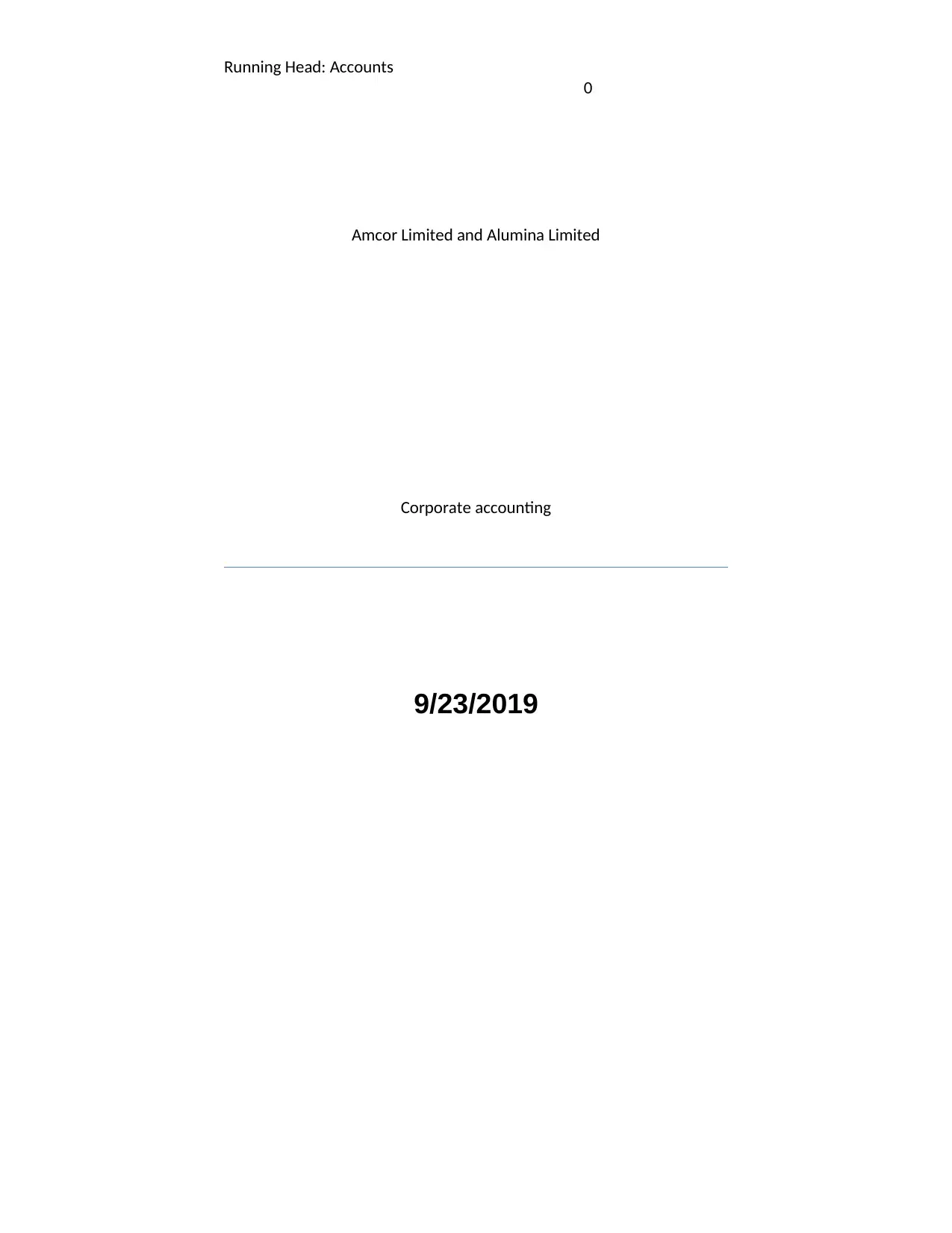
Running Head: Accounts
0
Amcor Limited and Alumina Limited
Corporate accounting
9/23/2019
0
Amcor Limited and Alumina Limited
Corporate accounting
9/23/2019
Secure Best Marks with AI Grader
Need help grading? Try our AI Grader for instant feedback on your assignments.
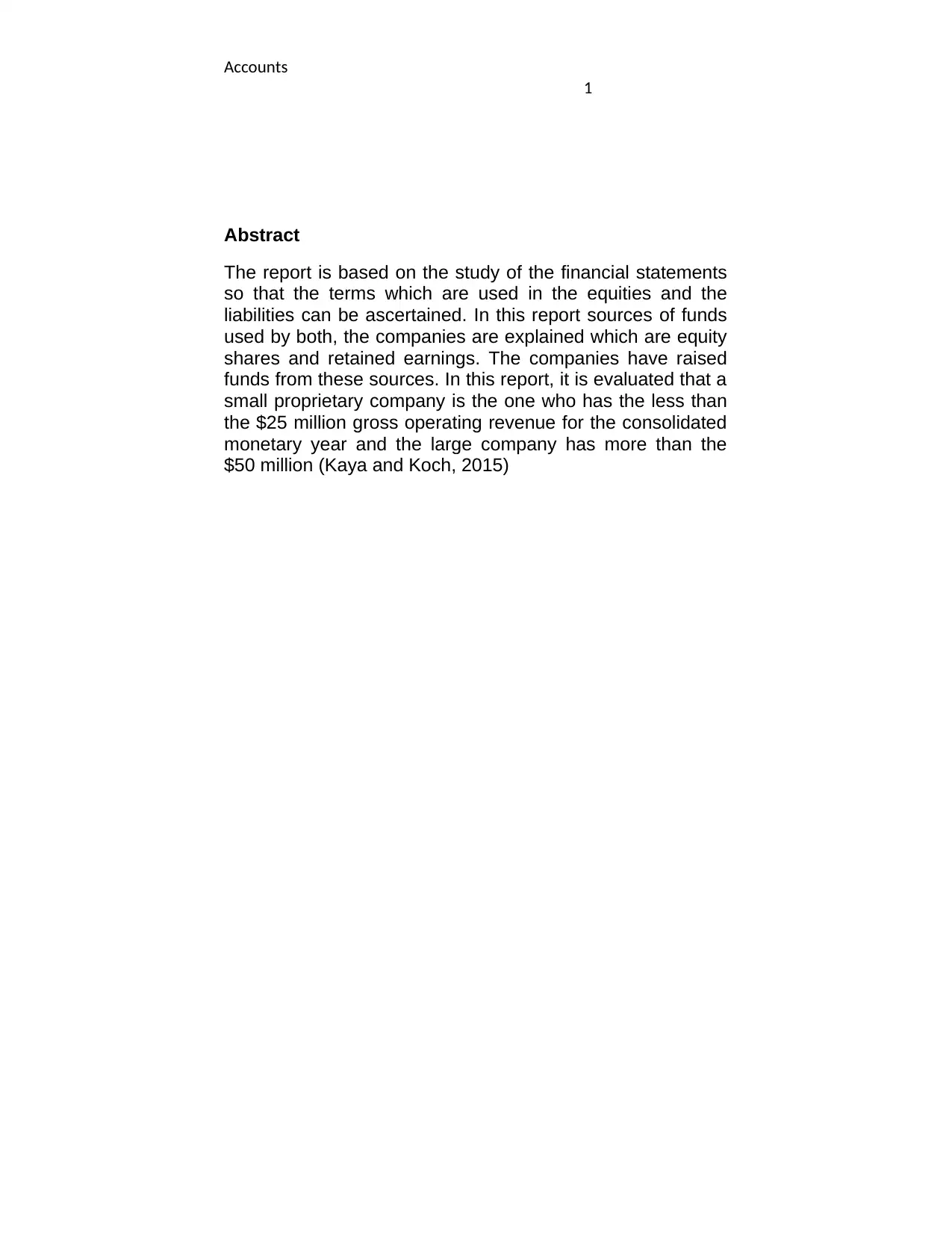
Accounts
1
Abstract
The report is based on the study of the financial statements
so that the terms which are used in the equities and the
liabilities can be ascertained. In this report sources of funds
used by both, the companies are explained which are equity
shares and retained earnings. The companies have raised
funds from these sources. In this report, it is evaluated that a
small proprietary company is the one who has the less than
the $25 million gross operating revenue for the consolidated
monetary year and the large company has more than the
$50 million (Kaya and Koch, 2015)
1
Abstract
The report is based on the study of the financial statements
so that the terms which are used in the equities and the
liabilities can be ascertained. In this report sources of funds
used by both, the companies are explained which are equity
shares and retained earnings. The companies have raised
funds from these sources. In this report, it is evaluated that a
small proprietary company is the one who has the less than
the $25 million gross operating revenue for the consolidated
monetary year and the large company has more than the
$50 million (Kaya and Koch, 2015)
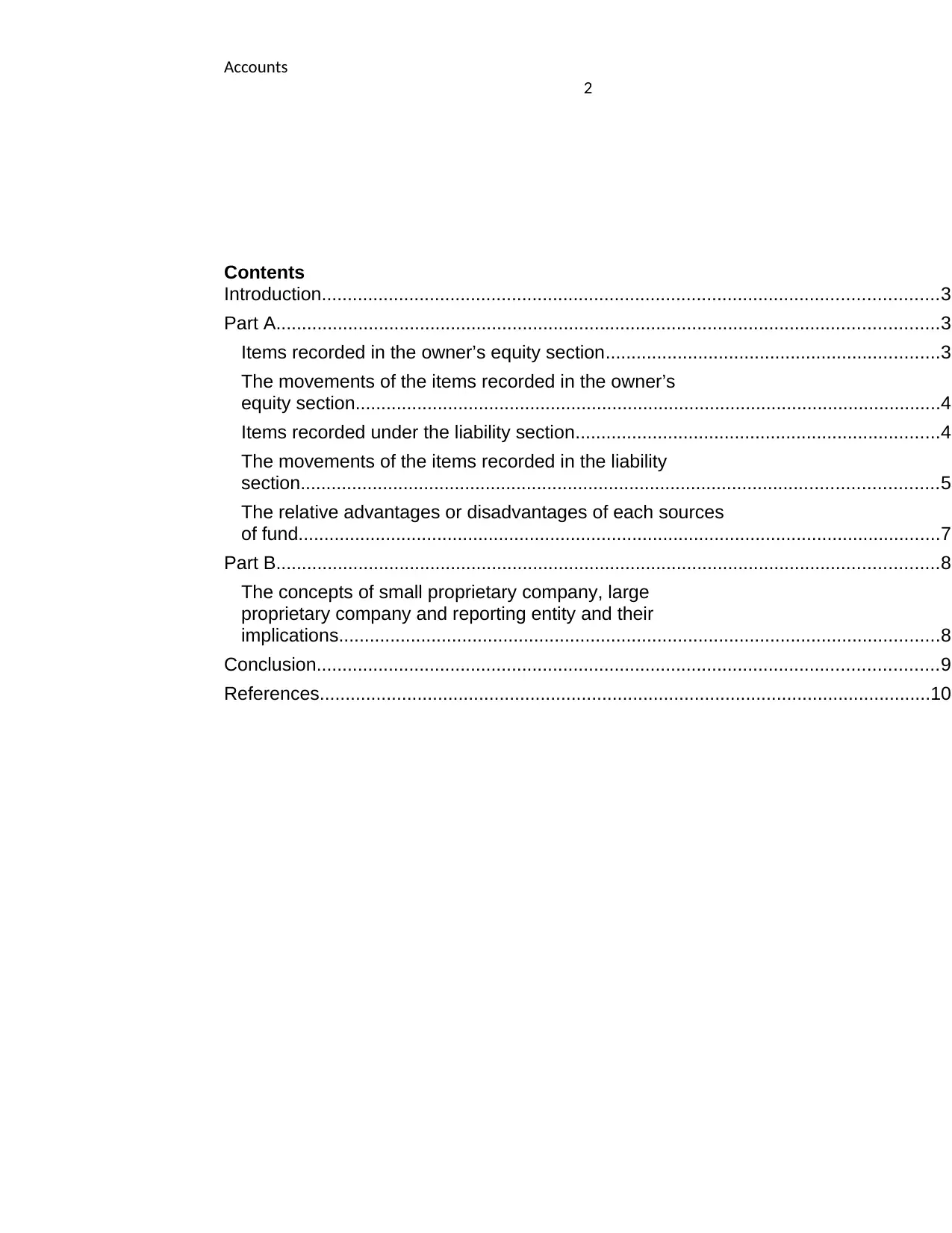
Accounts
2
Contents
Introduction........................................................................................................................3
Part A.................................................................................................................................3
Items recorded in the owner’s equity section.................................................................3
The movements of the items recorded in the owner’s
equity section..................................................................................................................4
Items recorded under the liability section.......................................................................4
The movements of the items recorded in the liability
section............................................................................................................................5
The relative advantages or disadvantages of each sources
of fund.............................................................................................................................7
Part B.................................................................................................................................8
The concepts of small proprietary company, large
proprietary company and reporting entity and their
implications.....................................................................................................................8
Conclusion.........................................................................................................................9
References.......................................................................................................................10
2
Contents
Introduction........................................................................................................................3
Part A.................................................................................................................................3
Items recorded in the owner’s equity section.................................................................3
The movements of the items recorded in the owner’s
equity section..................................................................................................................4
Items recorded under the liability section.......................................................................4
The movements of the items recorded in the liability
section............................................................................................................................5
The relative advantages or disadvantages of each sources
of fund.............................................................................................................................7
Part B.................................................................................................................................8
The concepts of small proprietary company, large
proprietary company and reporting entity and their
implications.....................................................................................................................8
Conclusion.........................................................................................................................9
References.......................................................................................................................10
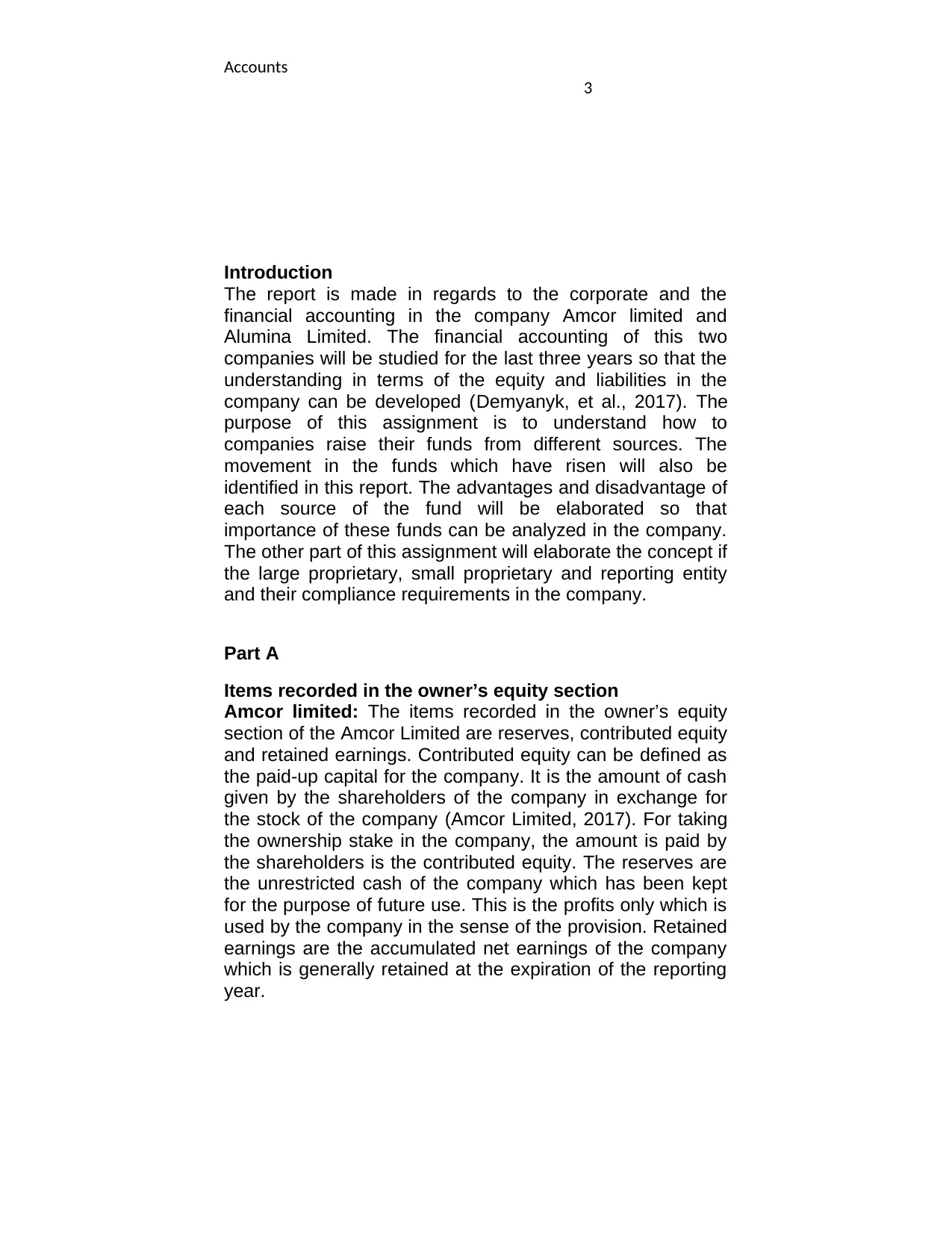
Accounts
3
Introduction
The report is made in regards to the corporate and the
financial accounting in the company Amcor limited and
Alumina Limited. The financial accounting of this two
companies will be studied for the last three years so that the
understanding in terms of the equity and liabilities in the
company can be developed (Demyanyk, et al., 2017). The
purpose of this assignment is to understand how to
companies raise their funds from different sources. The
movement in the funds which have risen will also be
identified in this report. The advantages and disadvantage of
each source of the fund will be elaborated so that
importance of these funds can be analyzed in the company.
The other part of this assignment will elaborate the concept if
the large proprietary, small proprietary and reporting entity
and their compliance requirements in the company.
Part A
Items recorded in the owner’s equity section
Amcor limited: The items recorded in the owner’s equity
section of the Amcor Limited are reserves, contributed equity
and retained earnings. Contributed equity can be defined as
the paid-up capital for the company. It is the amount of cash
given by the shareholders of the company in exchange for
the stock of the company (Amcor Limited, 2017). For taking
the ownership stake in the company, the amount is paid by
the shareholders is the contributed equity. The reserves are
the unrestricted cash of the company which has been kept
for the purpose of future use. This is the profits only which is
used by the company in the sense of the provision. Retained
earnings are the accumulated net earnings of the company
which is generally retained at the expiration of the reporting
year.
3
Introduction
The report is made in regards to the corporate and the
financial accounting in the company Amcor limited and
Alumina Limited. The financial accounting of this two
companies will be studied for the last three years so that the
understanding in terms of the equity and liabilities in the
company can be developed (Demyanyk, et al., 2017). The
purpose of this assignment is to understand how to
companies raise their funds from different sources. The
movement in the funds which have risen will also be
identified in this report. The advantages and disadvantage of
each source of the fund will be elaborated so that
importance of these funds can be analyzed in the company.
The other part of this assignment will elaborate the concept if
the large proprietary, small proprietary and reporting entity
and their compliance requirements in the company.
Part A
Items recorded in the owner’s equity section
Amcor limited: The items recorded in the owner’s equity
section of the Amcor Limited are reserves, contributed equity
and retained earnings. Contributed equity can be defined as
the paid-up capital for the company. It is the amount of cash
given by the shareholders of the company in exchange for
the stock of the company (Amcor Limited, 2017). For taking
the ownership stake in the company, the amount is paid by
the shareholders is the contributed equity. The reserves are
the unrestricted cash of the company which has been kept
for the purpose of future use. This is the profits only which is
used by the company in the sense of the provision. Retained
earnings are the accumulated net earnings of the company
which is generally retained at the expiration of the reporting
year.
Secure Best Marks with AI Grader
Need help grading? Try our AI Grader for instant feedback on your assignments.
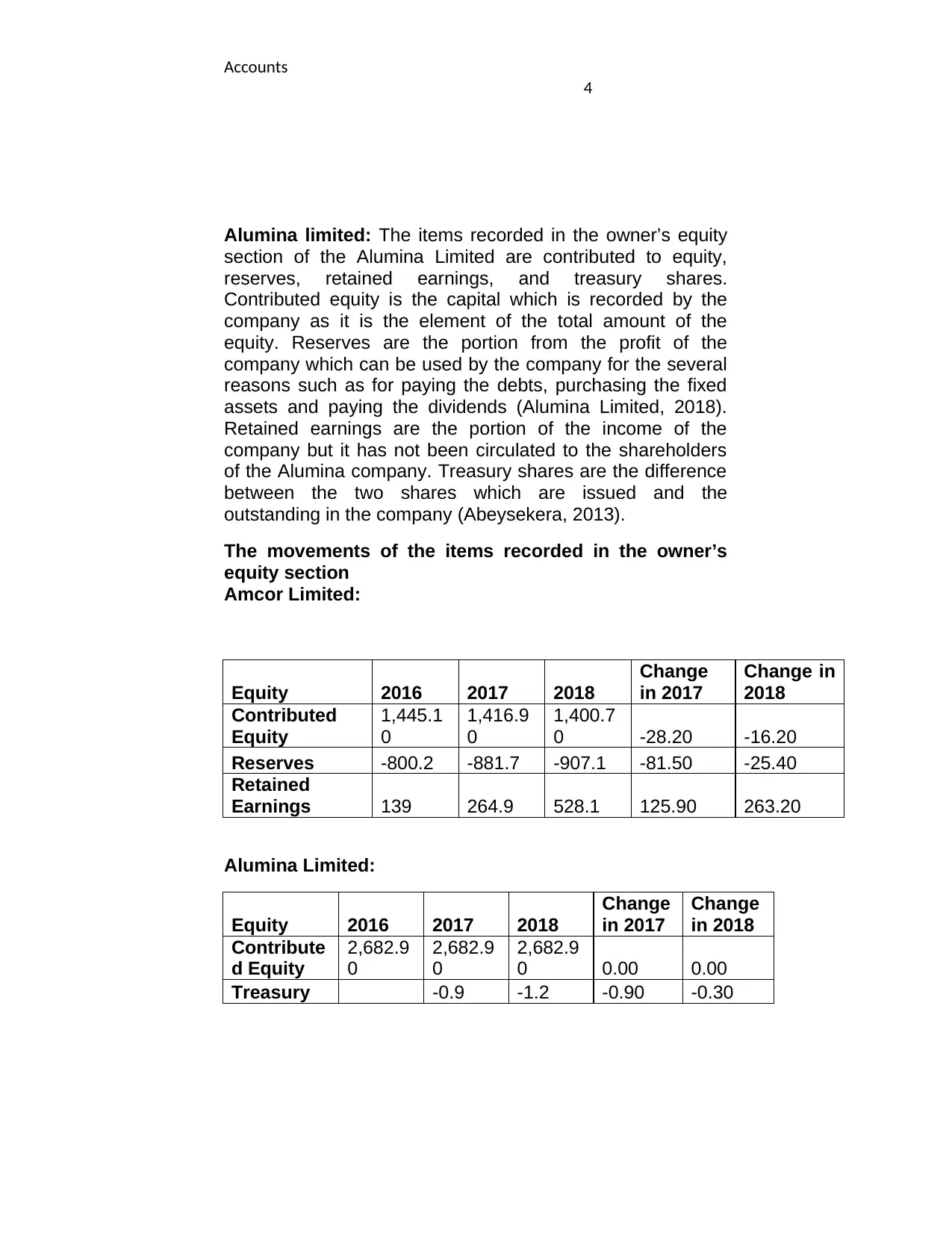
Accounts
4
Alumina limited: The items recorded in the owner’s equity
section of the Alumina Limited are contributed to equity,
reserves, retained earnings, and treasury shares.
Contributed equity is the capital which is recorded by the
company as it is the element of the total amount of the
equity. Reserves are the portion from the profit of the
company which can be used by the company for the several
reasons such as for paying the debts, purchasing the fixed
assets and paying the dividends (Alumina Limited, 2018).
Retained earnings are the portion of the income of the
company but it has not been circulated to the shareholders
of the Alumina company. Treasury shares are the difference
between the two shares which are issued and the
outstanding in the company (Abeysekera, 2013).
The movements of the items recorded in the owner’s
equity section
Amcor Limited:
Equity 2016 2017 2018
Change
in 2017
Change in
2018
Contributed
Equity
1,445.1
0
1,416.9
0
1,400.7
0 -28.20 -16.20
Reserves -800.2 -881.7 -907.1 -81.50 -25.40
Retained
Earnings 139 264.9 528.1 125.90 263.20
Alumina Limited:
Equity 2016 2017 2018
Change
in 2017
Change
in 2018
Contribute
d Equity
2,682.9
0
2,682.9
0
2,682.9
0 0.00 0.00
Treasury -0.9 -1.2 -0.90 -0.30
4
Alumina limited: The items recorded in the owner’s equity
section of the Alumina Limited are contributed to equity,
reserves, retained earnings, and treasury shares.
Contributed equity is the capital which is recorded by the
company as it is the element of the total amount of the
equity. Reserves are the portion from the profit of the
company which can be used by the company for the several
reasons such as for paying the debts, purchasing the fixed
assets and paying the dividends (Alumina Limited, 2018).
Retained earnings are the portion of the income of the
company but it has not been circulated to the shareholders
of the Alumina company. Treasury shares are the difference
between the two shares which are issued and the
outstanding in the company (Abeysekera, 2013).
The movements of the items recorded in the owner’s
equity section
Amcor Limited:
Equity 2016 2017 2018
Change
in 2017
Change in
2018
Contributed
Equity
1,445.1
0
1,416.9
0
1,400.7
0 -28.20 -16.20
Reserves -800.2 -881.7 -907.1 -81.50 -25.40
Retained
Earnings 139 264.9 528.1 125.90 263.20
Alumina Limited:
Equity 2016 2017 2018
Change
in 2017
Change
in 2018
Contribute
d Equity
2,682.9
0
2,682.9
0
2,682.9
0 0.00 0.00
Treasury -0.9 -1.2 -0.90 -0.30
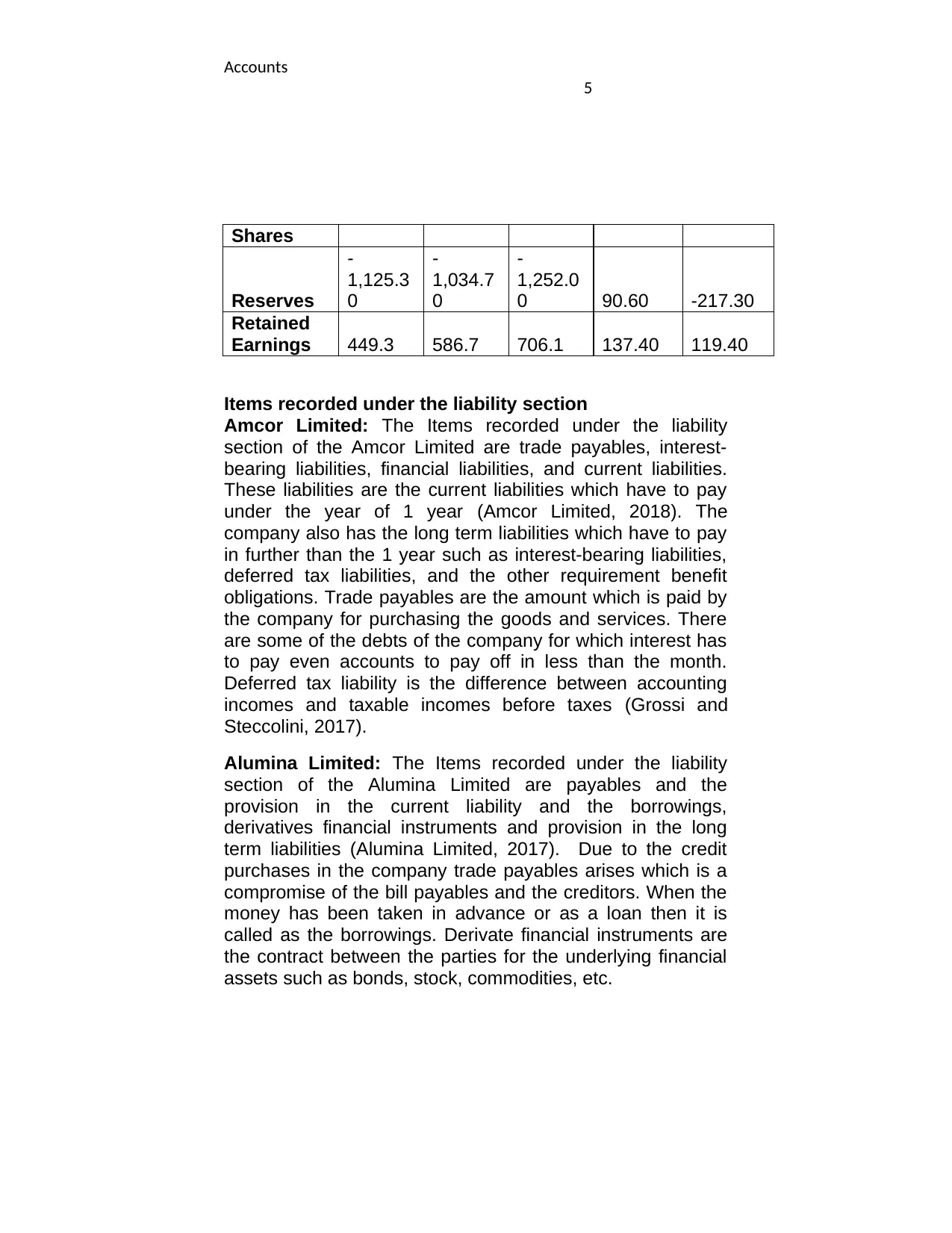
Accounts
5
Shares
Reserves
-
1,125.3
0
-
1,034.7
0
-
1,252.0
0 90.60 -217.30
Retained
Earnings 449.3 586.7 706.1 137.40 119.40
Items recorded under the liability section
Amcor Limited: The Items recorded under the liability
section of the Amcor Limited are trade payables, interest-
bearing liabilities, financial liabilities, and current liabilities.
These liabilities are the current liabilities which have to pay
under the year of 1 year (Amcor Limited, 2018). The
company also has the long term liabilities which have to pay
in further than the 1 year such as interest-bearing liabilities,
deferred tax liabilities, and the other requirement benefit
obligations. Trade payables are the amount which is paid by
the company for purchasing the goods and services. There
are some of the debts of the company for which interest has
to pay even accounts to pay off in less than the month.
Deferred tax liability is the difference between accounting
incomes and taxable incomes before taxes (Grossi and
Steccolini, 2017).
Alumina Limited: The Items recorded under the liability
section of the Alumina Limited are payables and the
provision in the current liability and the borrowings,
derivatives financial instruments and provision in the long
term liabilities (Alumina Limited, 2017). Due to the credit
purchases in the company trade payables arises which is a
compromise of the bill payables and the creditors. When the
money has been taken in advance or as a loan then it is
called as the borrowings. Derivate financial instruments are
the contract between the parties for the underlying financial
assets such as bonds, stock, commodities, etc.
5
Shares
Reserves
-
1,125.3
0
-
1,034.7
0
-
1,252.0
0 90.60 -217.30
Retained
Earnings 449.3 586.7 706.1 137.40 119.40
Items recorded under the liability section
Amcor Limited: The Items recorded under the liability
section of the Amcor Limited are trade payables, interest-
bearing liabilities, financial liabilities, and current liabilities.
These liabilities are the current liabilities which have to pay
under the year of 1 year (Amcor Limited, 2018). The
company also has the long term liabilities which have to pay
in further than the 1 year such as interest-bearing liabilities,
deferred tax liabilities, and the other requirement benefit
obligations. Trade payables are the amount which is paid by
the company for purchasing the goods and services. There
are some of the debts of the company for which interest has
to pay even accounts to pay off in less than the month.
Deferred tax liability is the difference between accounting
incomes and taxable incomes before taxes (Grossi and
Steccolini, 2017).
Alumina Limited: The Items recorded under the liability
section of the Alumina Limited are payables and the
provision in the current liability and the borrowings,
derivatives financial instruments and provision in the long
term liabilities (Alumina Limited, 2017). Due to the credit
purchases in the company trade payables arises which is a
compromise of the bill payables and the creditors. When the
money has been taken in advance or as a loan then it is
called as the borrowings. Derivate financial instruments are
the contract between the parties for the underlying financial
assets such as bonds, stock, commodities, etc.
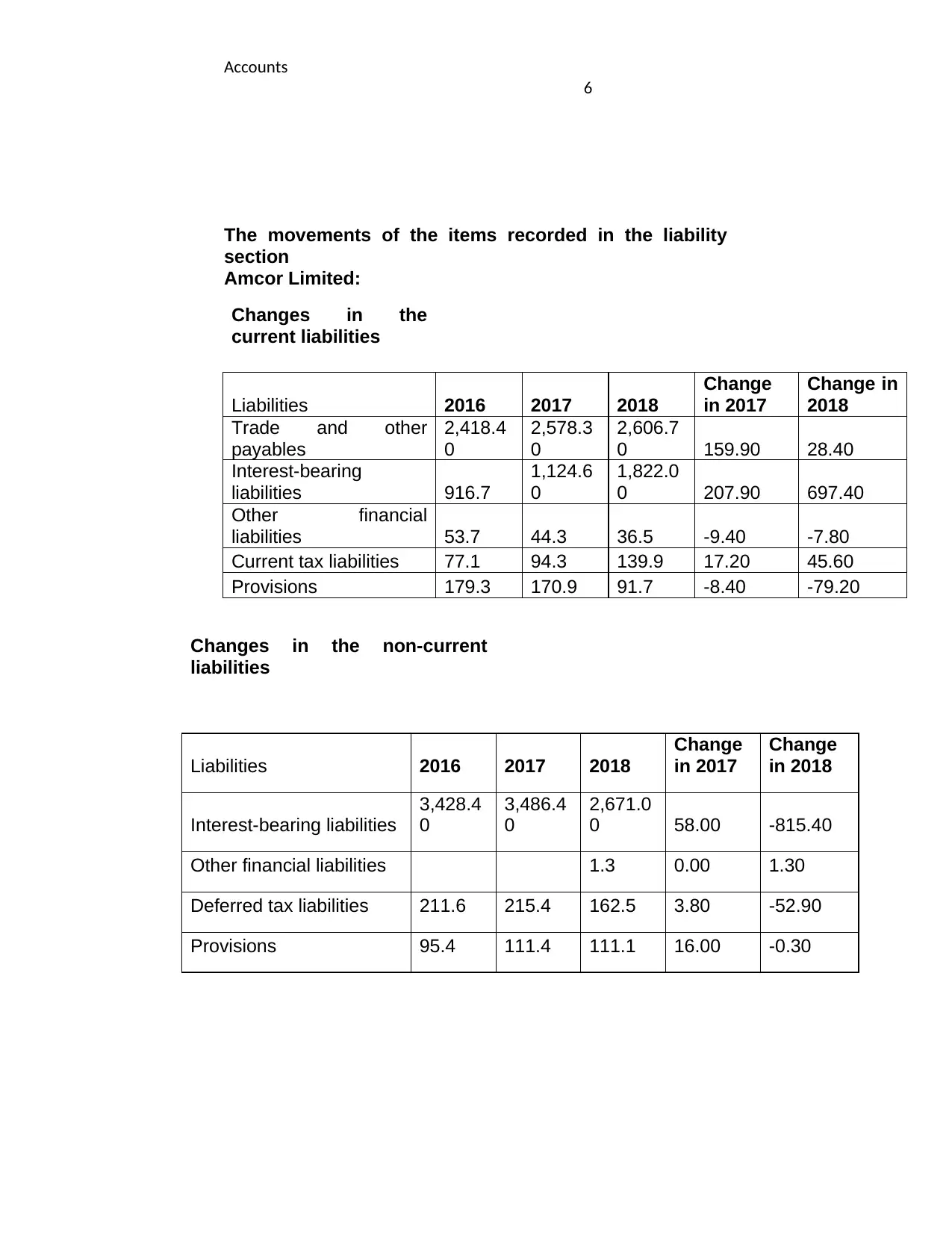
Accounts
6
The movements of the items recorded in the liability
section
Amcor Limited:
Changes in the
current liabilities
Liabilities 2016 2017 2018
Change
in 2017
Change in
2018
Trade and other
payables
2,418.4
0
2,578.3
0
2,606.7
0 159.90 28.40
Interest-bearing
liabilities 916.7
1,124.6
0
1,822.0
0 207.90 697.40
Other financial
liabilities 53.7 44.3 36.5 -9.40 -7.80
Current tax liabilities 77.1 94.3 139.9 17.20 45.60
Provisions 179.3 170.9 91.7 -8.40 -79.20
Changes in the non-current
liabilities
Liabilities 2016 2017 2018
Change
in 2017
Change
in 2018
Interest-bearing liabilities
3,428.4
0
3,486.4
0
2,671.0
0 58.00 -815.40
Other financial liabilities 1.3 0.00 1.30
Deferred tax liabilities 211.6 215.4 162.5 3.80 -52.90
Provisions 95.4 111.4 111.1 16.00 -0.30
6
The movements of the items recorded in the liability
section
Amcor Limited:
Changes in the
current liabilities
Liabilities 2016 2017 2018
Change
in 2017
Change in
2018
Trade and other
payables
2,418.4
0
2,578.3
0
2,606.7
0 159.90 28.40
Interest-bearing
liabilities 916.7
1,124.6
0
1,822.0
0 207.90 697.40
Other financial
liabilities 53.7 44.3 36.5 -9.40 -7.80
Current tax liabilities 77.1 94.3 139.9 17.20 45.60
Provisions 179.3 170.9 91.7 -8.40 -79.20
Changes in the non-current
liabilities
Liabilities 2016 2017 2018
Change
in 2017
Change
in 2018
Interest-bearing liabilities
3,428.4
0
3,486.4
0
2,671.0
0 58.00 -815.40
Other financial liabilities 1.3 0.00 1.30
Deferred tax liabilities 211.6 215.4 162.5 3.80 -52.90
Provisions 95.4 111.4 111.1 16.00 -0.30
Paraphrase This Document
Need a fresh take? Get an instant paraphrase of this document with our AI Paraphraser
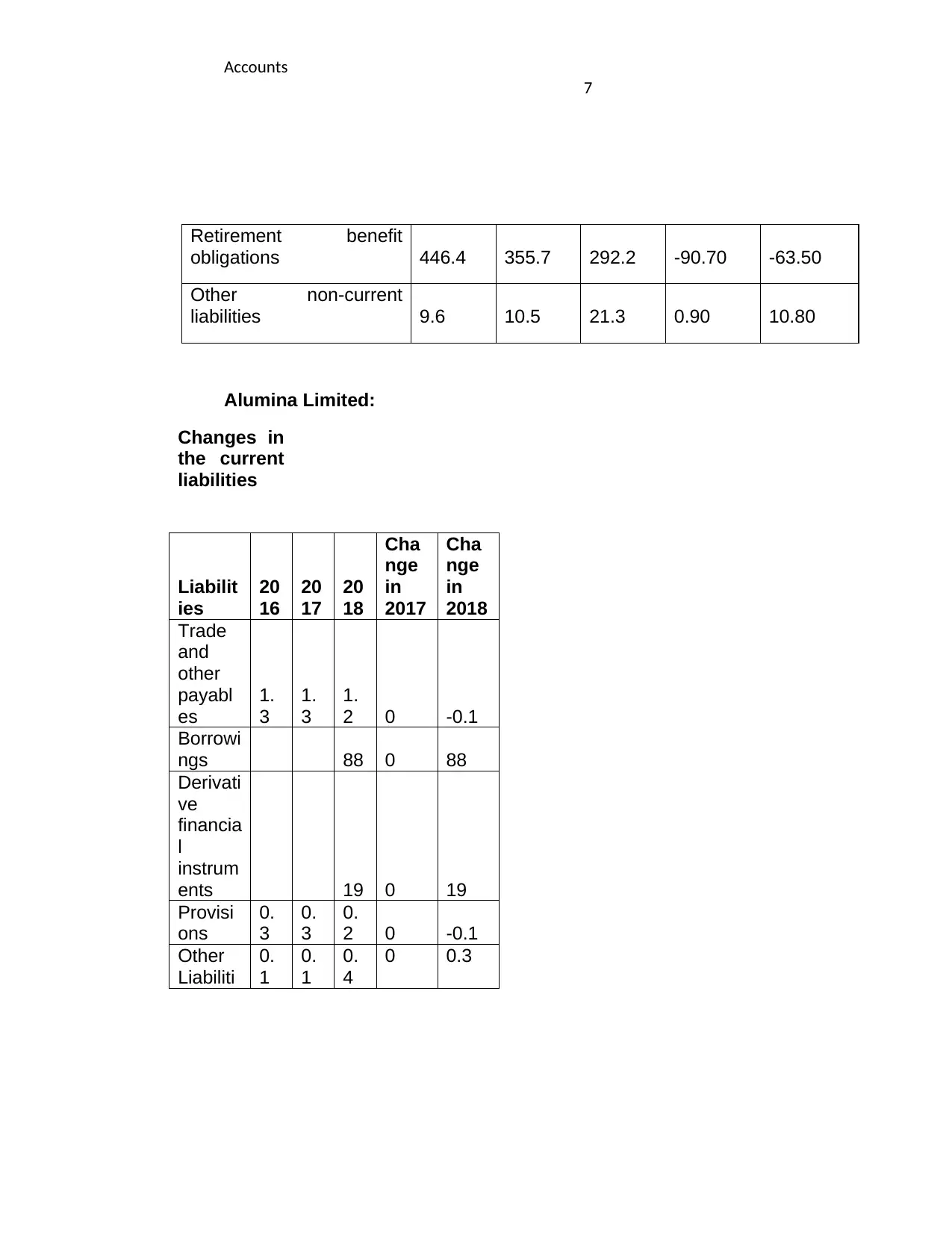
Accounts
7
Retirement benefit
obligations 446.4 355.7 292.2 -90.70 -63.50
Other non-current
liabilities 9.6 10.5 21.3 0.90 10.80
Alumina Limited:
Changes in
the current
liabilities
Liabilit
ies
20
16
20
17
20
18
Cha
nge
in
2017
Cha
nge
in
2018
Trade
and
other
payabl
es
1.
3
1.
3
1.
2 0 -0.1
Borrowi
ngs 88 0 88
Derivati
ve
financia
l
instrum
ents 19 0 19
Provisi
ons
0.
3
0.
3
0.
2 0 -0.1
Other
Liabiliti
0.
1
0.
1
0.
4
0 0.3
7
Retirement benefit
obligations 446.4 355.7 292.2 -90.70 -63.50
Other non-current
liabilities 9.6 10.5 21.3 0.90 10.80
Alumina Limited:
Changes in
the current
liabilities
Liabilit
ies
20
16
20
17
20
18
Cha
nge
in
2017
Cha
nge
in
2018
Trade
and
other
payabl
es
1.
3
1.
3
1.
2 0 -0.1
Borrowi
ngs 88 0 88
Derivati
ve
financia
l
instrum
ents 19 0 19
Provisi
ons
0.
3
0.
3
0.
2 0 -0.1
Other
Liabiliti
0.
1
0.
1
0.
4
0 0.3
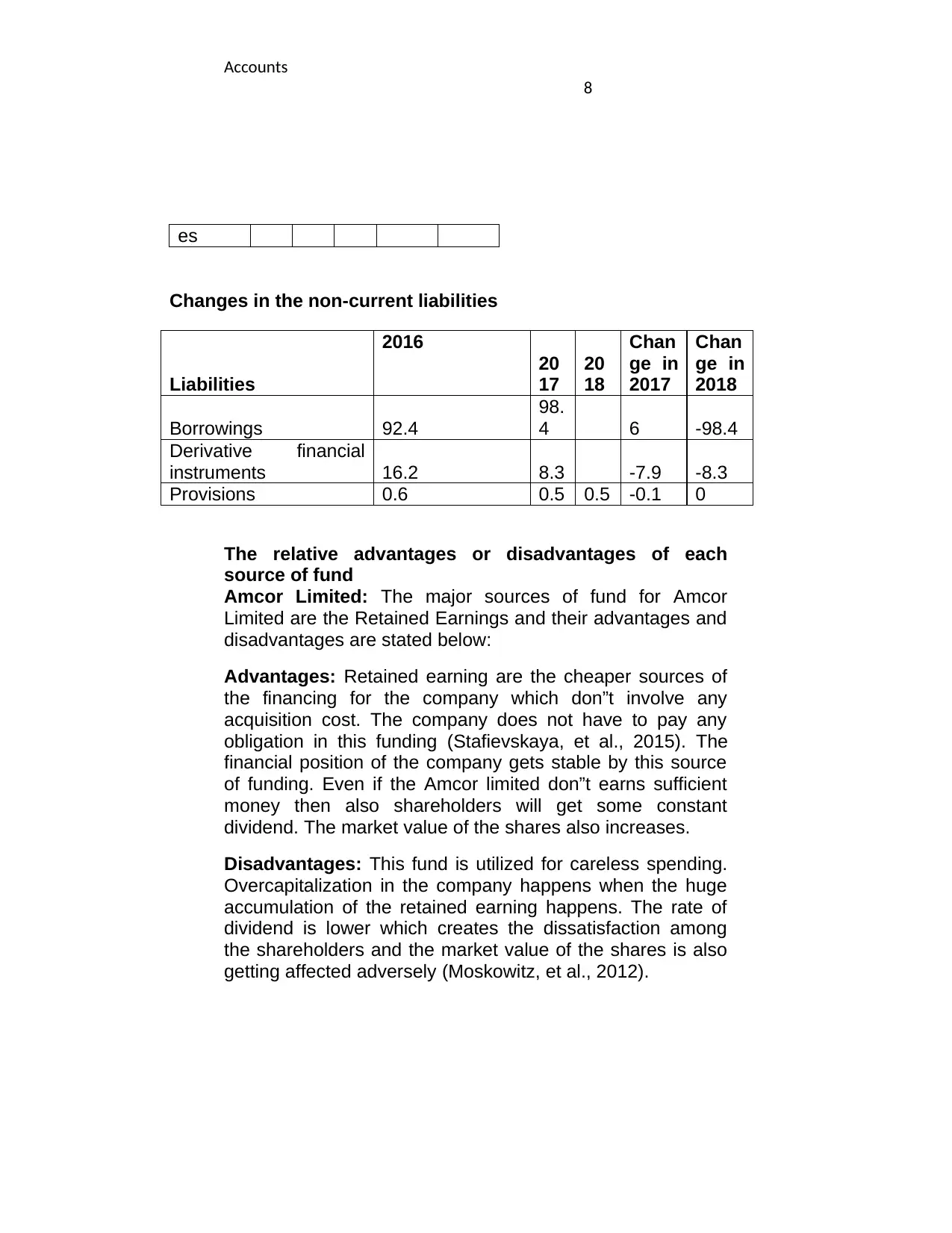
Accounts
8
es
Changes in the non-current liabilities
Liabilities
2016
20
17
20
18
Chan
ge in
2017
Chan
ge in
2018
Borrowings 92.4
98.
4 6 -98.4
Derivative financial
instruments 16.2 8.3 -7.9 -8.3
Provisions 0.6 0.5 0.5 -0.1 0
The relative advantages or disadvantages of each
source of fund
Amcor Limited: The major sources of fund for Amcor
Limited are the Retained Earnings and their advantages and
disadvantages are stated below:
Advantages: Retained earning are the cheaper sources of
the financing for the company which don”t involve any
acquisition cost. The company does not have to pay any
obligation in this funding (Stafievskaya, et al., 2015). The
financial position of the company gets stable by this source
of funding. Even if the Amcor limited don”t earns sufficient
money then also shareholders will get some constant
dividend. The market value of the shares also increases.
Disadvantages: This fund is utilized for careless spending.
Overcapitalization in the company happens when the huge
accumulation of the retained earning happens. The rate of
dividend is lower which creates the dissatisfaction among
the shareholders and the market value of the shares is also
getting affected adversely (Moskowitz, et al., 2012).
8
es
Changes in the non-current liabilities
Liabilities
2016
20
17
20
18
Chan
ge in
2017
Chan
ge in
2018
Borrowings 92.4
98.
4 6 -98.4
Derivative financial
instruments 16.2 8.3 -7.9 -8.3
Provisions 0.6 0.5 0.5 -0.1 0
The relative advantages or disadvantages of each
source of fund
Amcor Limited: The major sources of fund for Amcor
Limited are the Retained Earnings and their advantages and
disadvantages are stated below:
Advantages: Retained earning are the cheaper sources of
the financing for the company which don”t involve any
acquisition cost. The company does not have to pay any
obligation in this funding (Stafievskaya, et al., 2015). The
financial position of the company gets stable by this source
of funding. Even if the Amcor limited don”t earns sufficient
money then also shareholders will get some constant
dividend. The market value of the shares also increases.
Disadvantages: This fund is utilized for careless spending.
Overcapitalization in the company happens when the huge
accumulation of the retained earning happens. The rate of
dividend is lower which creates the dissatisfaction among
the shareholders and the market value of the shares is also
getting affected adversely (Moskowitz, et al., 2012).
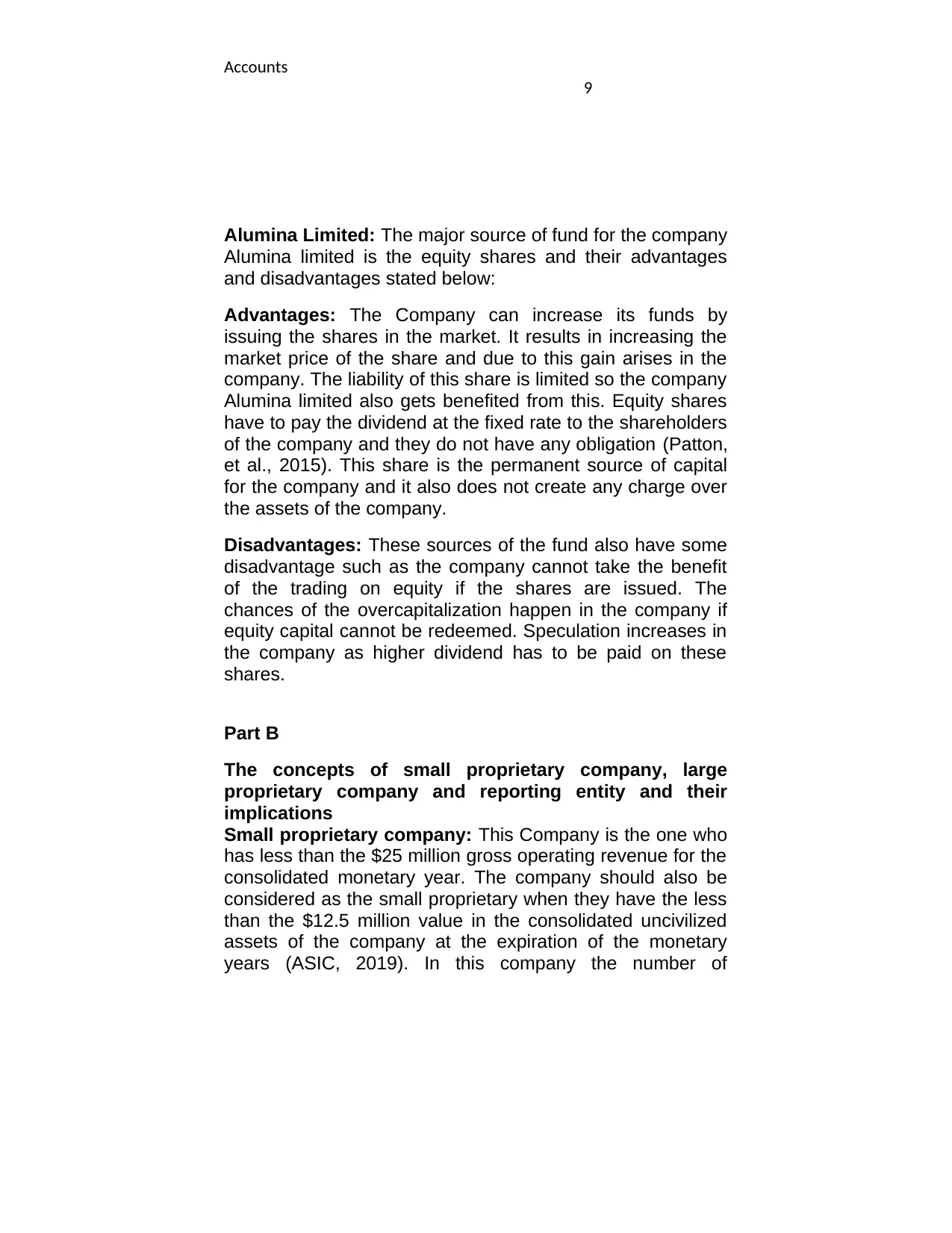
Accounts
9
Alumina Limited: The major source of fund for the company
Alumina limited is the equity shares and their advantages
and disadvantages stated below:
Advantages: The Company can increase its funds by
issuing the shares in the market. It results in increasing the
market price of the share and due to this gain arises in the
company. The liability of this share is limited so the company
Alumina limited also gets benefited from this. Equity shares
have to pay the dividend at the fixed rate to the shareholders
of the company and they do not have any obligation (Patton,
et al., 2015). This share is the permanent source of capital
for the company and it also does not create any charge over
the assets of the company.
Disadvantages: These sources of the fund also have some
disadvantage such as the company cannot take the benefit
of the trading on equity if the shares are issued. The
chances of the overcapitalization happen in the company if
equity capital cannot be redeemed. Speculation increases in
the company as higher dividend has to be paid on these
shares.
Part B
The concepts of small proprietary company, large
proprietary company and reporting entity and their
implications
Small proprietary company: This Company is the one who
has less than the $25 million gross operating revenue for the
consolidated monetary year. The company should also be
considered as the small proprietary when they have the less
than the $12.5 million value in the consolidated uncivilized
assets of the company at the expiration of the monetary
years (ASIC, 2019). In this company the number of
9
Alumina Limited: The major source of fund for the company
Alumina limited is the equity shares and their advantages
and disadvantages stated below:
Advantages: The Company can increase its funds by
issuing the shares in the market. It results in increasing the
market price of the share and due to this gain arises in the
company. The liability of this share is limited so the company
Alumina limited also gets benefited from this. Equity shares
have to pay the dividend at the fixed rate to the shareholders
of the company and they do not have any obligation (Patton,
et al., 2015). This share is the permanent source of capital
for the company and it also does not create any charge over
the assets of the company.
Disadvantages: These sources of the fund also have some
disadvantage such as the company cannot take the benefit
of the trading on equity if the shares are issued. The
chances of the overcapitalization happen in the company if
equity capital cannot be redeemed. Speculation increases in
the company as higher dividend has to be paid on these
shares.
Part B
The concepts of small proprietary company, large
proprietary company and reporting entity and their
implications
Small proprietary company: This Company is the one who
has less than the $25 million gross operating revenue for the
consolidated monetary year. The company should also be
considered as the small proprietary when they have the less
than the $12.5 million value in the consolidated uncivilized
assets of the company at the expiration of the monetary
years (ASIC, 2019). In this company the number of
Secure Best Marks with AI Grader
Need help grading? Try our AI Grader for instant feedback on your assignments.
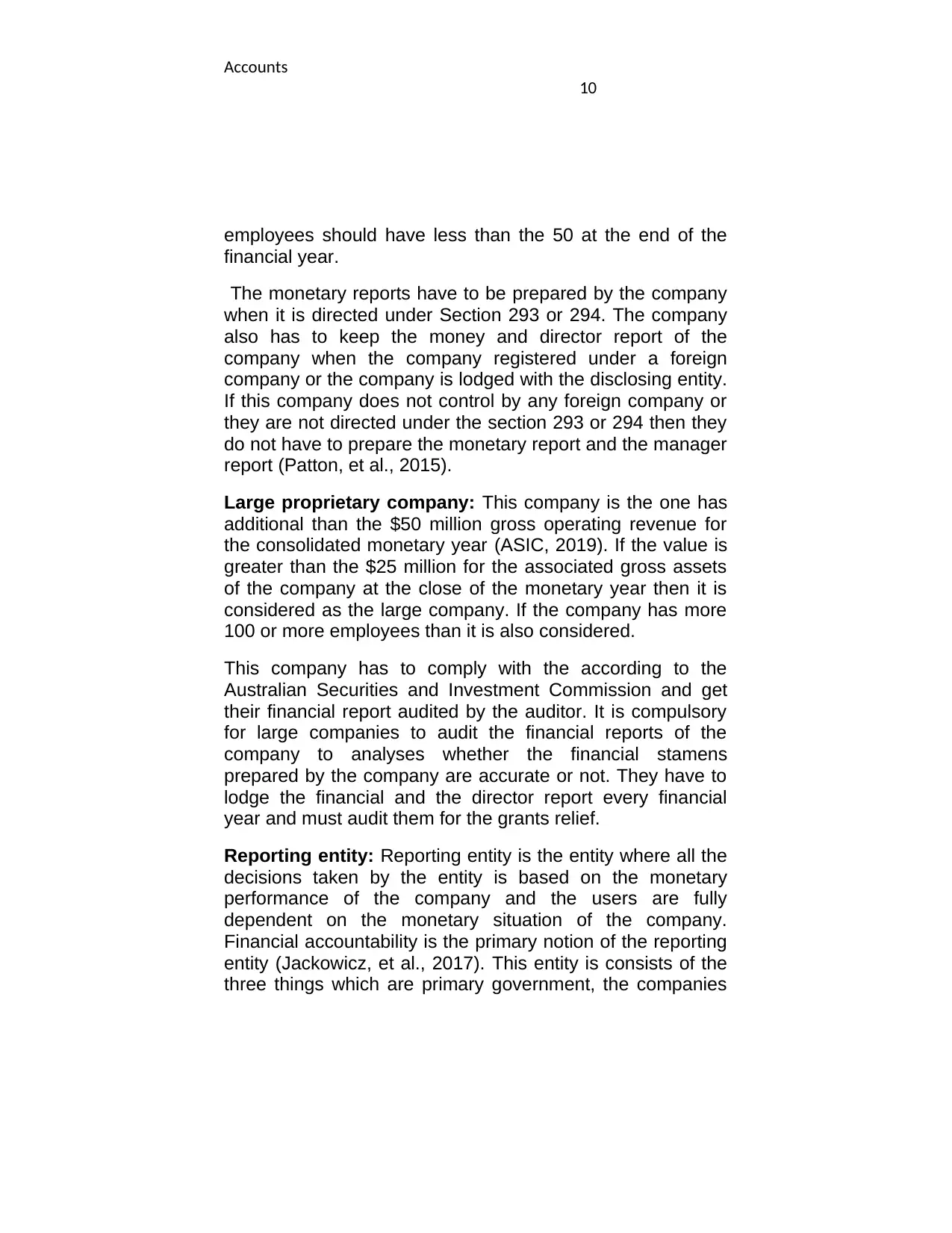
Accounts
10
employees should have less than the 50 at the end of the
financial year.
The monetary reports have to be prepared by the company
when it is directed under Section 293 or 294. The company
also has to keep the money and director report of the
company when the company registered under a foreign
company or the company is lodged with the disclosing entity.
If this company does not control by any foreign company or
they are not directed under the section 293 or 294 then they
do not have to prepare the monetary report and the manager
report (Patton, et al., 2015).
Large proprietary company: This company is the one has
additional than the $50 million gross operating revenue for
the consolidated monetary year (ASIC, 2019). If the value is
greater than the $25 million for the associated gross assets
of the company at the close of the monetary year then it is
considered as the large company. If the company has more
100 or more employees than it is also considered.
This company has to comply with the according to the
Australian Securities and Investment Commission and get
their financial report audited by the auditor. It is compulsory
for large companies to audit the financial reports of the
company to analyses whether the financial stamens
prepared by the company are accurate or not. They have to
lodge the financial and the director report every financial
year and must audit them for the grants relief.
Reporting entity: Reporting entity is the entity where all the
decisions taken by the entity is based on the monetary
performance of the company and the users are fully
dependent on the monetary situation of the company.
Financial accountability is the primary notion of the reporting
entity (Jackowicz, et al., 2017). This entity is consists of the
three things which are primary government, the companies
10
employees should have less than the 50 at the end of the
financial year.
The monetary reports have to be prepared by the company
when it is directed under Section 293 or 294. The company
also has to keep the money and director report of the
company when the company registered under a foreign
company or the company is lodged with the disclosing entity.
If this company does not control by any foreign company or
they are not directed under the section 293 or 294 then they
do not have to prepare the monetary report and the manager
report (Patton, et al., 2015).
Large proprietary company: This company is the one has
additional than the $50 million gross operating revenue for
the consolidated monetary year (ASIC, 2019). If the value is
greater than the $25 million for the associated gross assets
of the company at the close of the monetary year then it is
considered as the large company. If the company has more
100 or more employees than it is also considered.
This company has to comply with the according to the
Australian Securities and Investment Commission and get
their financial report audited by the auditor. It is compulsory
for large companies to audit the financial reports of the
company to analyses whether the financial stamens
prepared by the company are accurate or not. They have to
lodge the financial and the director report every financial
year and must audit them for the grants relief.
Reporting entity: Reporting entity is the entity where all the
decisions taken by the entity is based on the monetary
performance of the company and the users are fully
dependent on the monetary situation of the company.
Financial accountability is the primary notion of the reporting
entity (Jackowicz, et al., 2017). This entity is consists of the
three things which are primary government, the companies
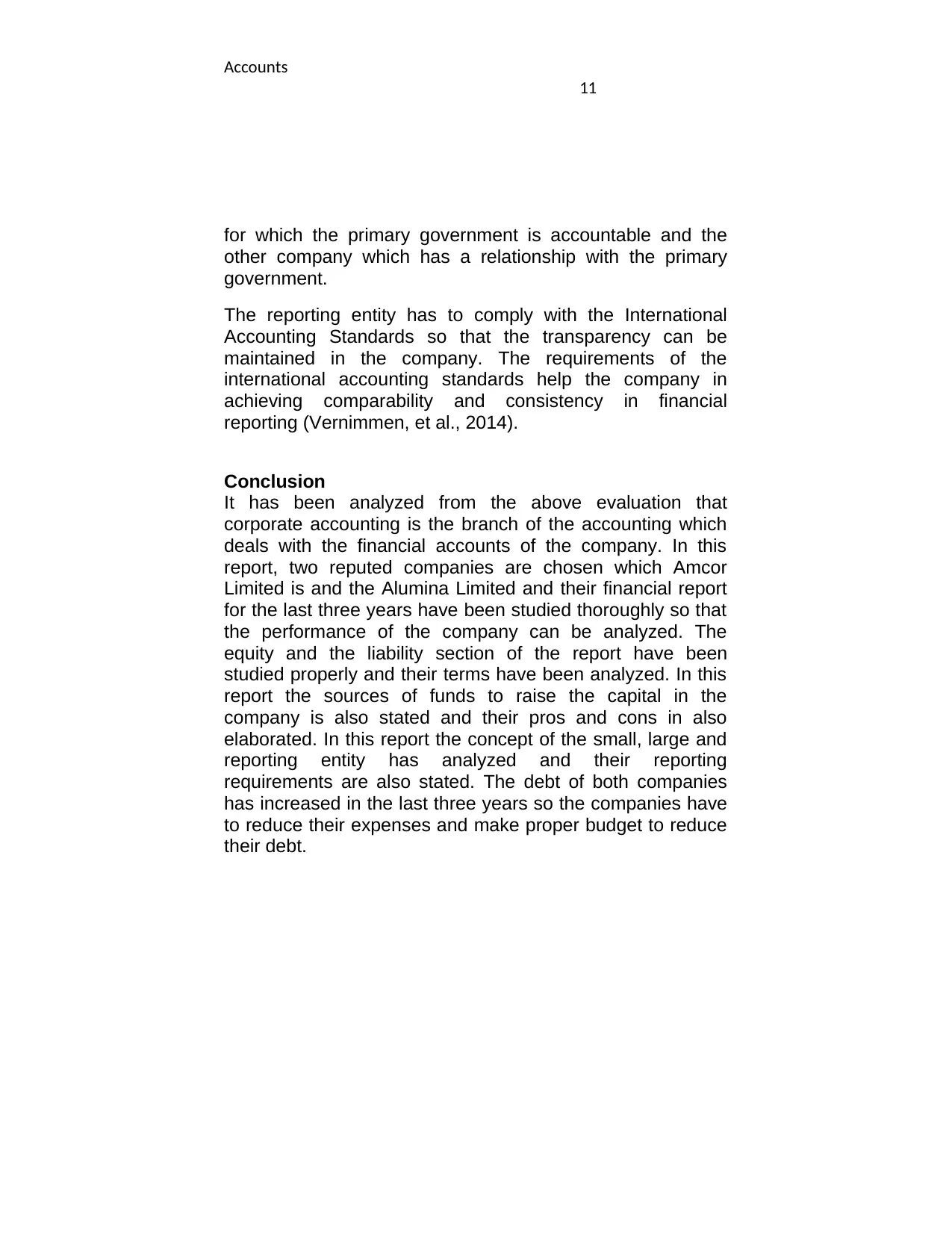
Accounts
11
for which the primary government is accountable and the
other company which has a relationship with the primary
government.
The reporting entity has to comply with the International
Accounting Standards so that the transparency can be
maintained in the company. The requirements of the
international accounting standards help the company in
achieving comparability and consistency in financial
reporting (Vernimmen, et al., 2014).
Conclusion
It has been analyzed from the above evaluation that
corporate accounting is the branch of the accounting which
deals with the financial accounts of the company. In this
report, two reputed companies are chosen which Amcor
Limited is and the Alumina Limited and their financial report
for the last three years have been studied thoroughly so that
the performance of the company can be analyzed. The
equity and the liability section of the report have been
studied properly and their terms have been analyzed. In this
report the sources of funds to raise the capital in the
company is also stated and their pros and cons in also
elaborated. In this report the concept of the small, large and
reporting entity has analyzed and their reporting
requirements are also stated. The debt of both companies
has increased in the last three years so the companies have
to reduce their expenses and make proper budget to reduce
their debt.
11
for which the primary government is accountable and the
other company which has a relationship with the primary
government.
The reporting entity has to comply with the International
Accounting Standards so that the transparency can be
maintained in the company. The requirements of the
international accounting standards help the company in
achieving comparability and consistency in financial
reporting (Vernimmen, et al., 2014).
Conclusion
It has been analyzed from the above evaluation that
corporate accounting is the branch of the accounting which
deals with the financial accounts of the company. In this
report, two reputed companies are chosen which Amcor
Limited is and the Alumina Limited and their financial report
for the last three years have been studied thoroughly so that
the performance of the company can be analyzed. The
equity and the liability section of the report have been
studied properly and their terms have been analyzed. In this
report the sources of funds to raise the capital in the
company is also stated and their pros and cons in also
elaborated. In this report the concept of the small, large and
reporting entity has analyzed and their reporting
requirements are also stated. The debt of both companies
has increased in the last three years so the companies have
to reduce their expenses and make proper budget to reduce
their debt.
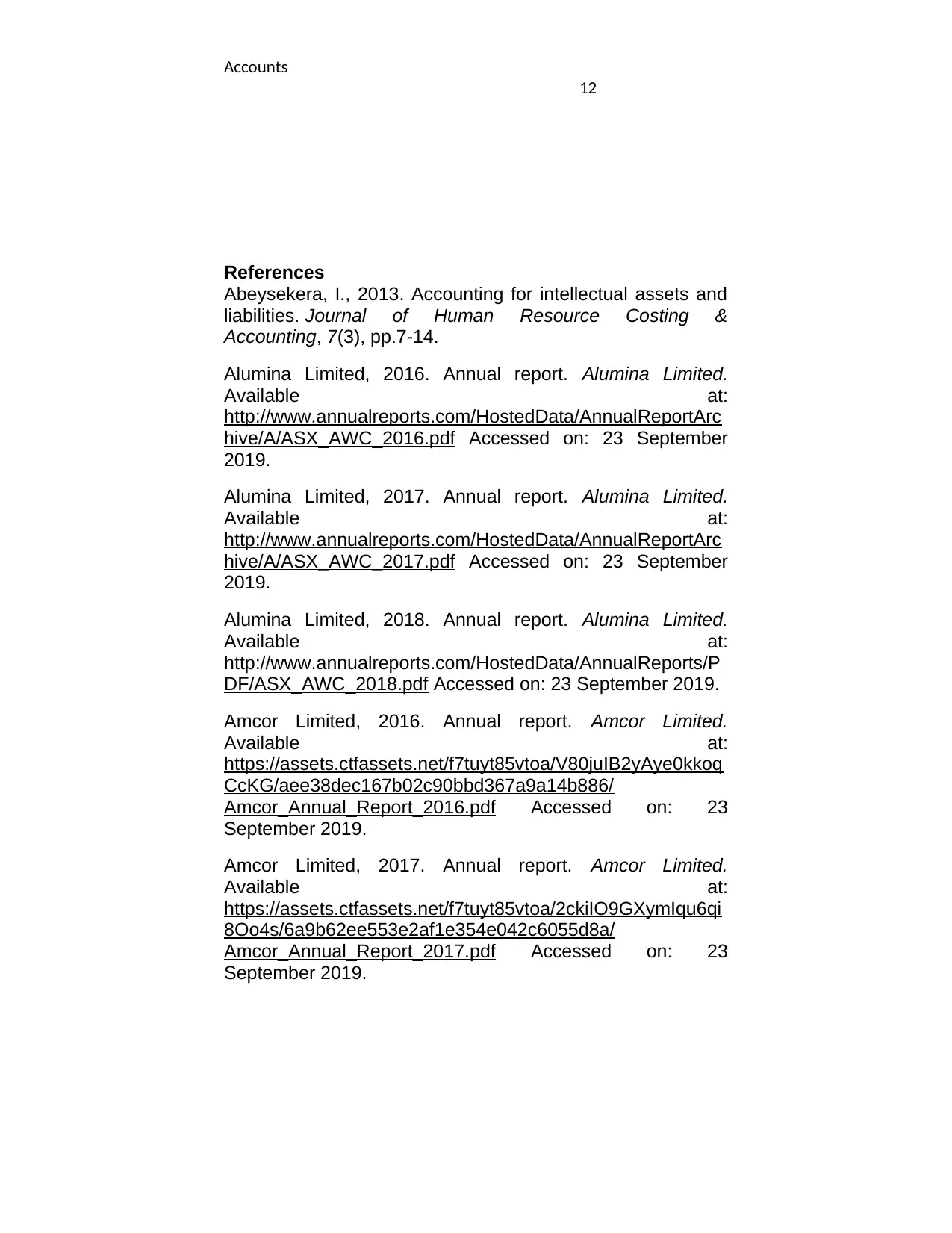
Accounts
12
References
Abeysekera, I., 2013. Accounting for intellectual assets and
liabilities. Journal of Human Resource Costing &
Accounting, 7(3), pp.7-14.
Alumina Limited, 2016. Annual report. Alumina Limited.
Available at:
http://www.annualreports.com/HostedData/AnnualReportArc
hive/A/ASX_AWC_2016.pdf Accessed on: 23 September
2019.
Alumina Limited, 2017. Annual report. Alumina Limited.
Available at:
http://www.annualreports.com/HostedData/AnnualReportArc
hive/A/ASX_AWC_2017.pdf Accessed on: 23 September
2019.
Alumina Limited, 2018. Annual report. Alumina Limited.
Available at:
http://www.annualreports.com/HostedData/AnnualReports/P
DF/ASX_AWC_2018.pdf Accessed on: 23 September 2019.
Amcor Limited, 2016. Annual report. Amcor Limited.
Available at:
https://assets.ctfassets.net/f7tuyt85vtoa/V80juIB2yAye0kkoq
CcKG/aee38dec167b02c90bbd367a9a14b886/
Amcor_Annual_Report_2016.pdf Accessed on: 23
September 2019.
Amcor Limited, 2017. Annual report. Amcor Limited.
Available at:
https://assets.ctfassets.net/f7tuyt85vtoa/2ckiIO9GXymIqu6qi
8Oo4s/6a9b62ee553e2af1e354e042c6055d8a/
Amcor_Annual_Report_2017.pdf Accessed on: 23
September 2019.
12
References
Abeysekera, I., 2013. Accounting for intellectual assets and
liabilities. Journal of Human Resource Costing &
Accounting, 7(3), pp.7-14.
Alumina Limited, 2016. Annual report. Alumina Limited.
Available at:
http://www.annualreports.com/HostedData/AnnualReportArc
hive/A/ASX_AWC_2016.pdf Accessed on: 23 September
2019.
Alumina Limited, 2017. Annual report. Alumina Limited.
Available at:
http://www.annualreports.com/HostedData/AnnualReportArc
hive/A/ASX_AWC_2017.pdf Accessed on: 23 September
2019.
Alumina Limited, 2018. Annual report. Alumina Limited.
Available at:
http://www.annualreports.com/HostedData/AnnualReports/P
DF/ASX_AWC_2018.pdf Accessed on: 23 September 2019.
Amcor Limited, 2016. Annual report. Amcor Limited.
Available at:
https://assets.ctfassets.net/f7tuyt85vtoa/V80juIB2yAye0kkoq
CcKG/aee38dec167b02c90bbd367a9a14b886/
Amcor_Annual_Report_2016.pdf Accessed on: 23
September 2019.
Amcor Limited, 2017. Annual report. Amcor Limited.
Available at:
https://assets.ctfassets.net/f7tuyt85vtoa/2ckiIO9GXymIqu6qi
8Oo4s/6a9b62ee553e2af1e354e042c6055d8a/
Amcor_Annual_Report_2017.pdf Accessed on: 23
September 2019.
Paraphrase This Document
Need a fresh take? Get an instant paraphrase of this document with our AI Paraphraser
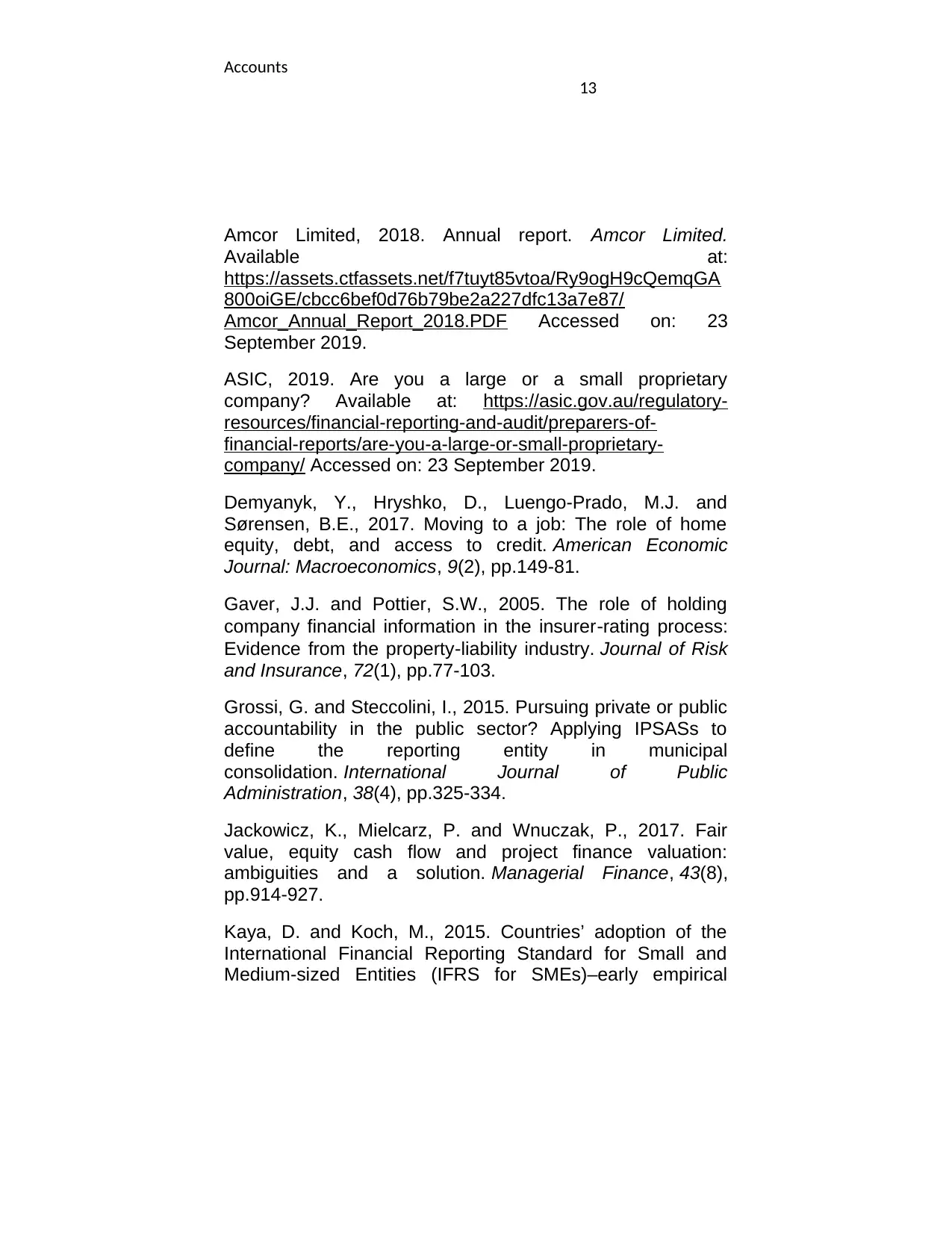
Accounts
13
Amcor Limited, 2018. Annual report. Amcor Limited.
Available at:
https://assets.ctfassets.net/f7tuyt85vtoa/Ry9ogH9cQemqGA
800oiGE/cbcc6bef0d76b79be2a227dfc13a7e87/
Amcor_Annual_Report_2018.PDF Accessed on: 23
September 2019.
ASIC, 2019. Are you a large or a small proprietary
company? Available at: https://asic.gov.au/regulatory-
resources/financial-reporting-and-audit/preparers-of-
financial-reports/are-you-a-large-or-small-proprietary-
company/ Accessed on: 23 September 2019.
Demyanyk, Y., Hryshko, D., Luengo-Prado, M.J. and
Sørensen, B.E., 2017. Moving to a job: The role of home
equity, debt, and access to credit. American Economic
Journal: Macroeconomics, 9(2), pp.149-81.
Gaver, J.J. and Pottier, S.W., 2005. The role of holding
company financial information in the insurer‐rating process:
Evidence from the property‐liability industry. Journal of Risk
and Insurance, 72(1), pp.77-103.
Grossi, G. and Steccolini, I., 2015. Pursuing private or public
accountability in the public sector? Applying IPSASs to
define the reporting entity in municipal
consolidation. International Journal of Public
Administration, 38(4), pp.325-334.
Jackowicz, K., Mielcarz, P. and Wnuczak, P., 2017. Fair
value, equity cash flow and project finance valuation:
ambiguities and a solution. Managerial Finance, 43(8),
pp.914-927.
Kaya, D. and Koch, M., 2015. Countries’ adoption of the
International Financial Reporting Standard for Small and
Medium-sized Entities (IFRS for SMEs)–early empirical
13
Amcor Limited, 2018. Annual report. Amcor Limited.
Available at:
https://assets.ctfassets.net/f7tuyt85vtoa/Ry9ogH9cQemqGA
800oiGE/cbcc6bef0d76b79be2a227dfc13a7e87/
Amcor_Annual_Report_2018.PDF Accessed on: 23
September 2019.
ASIC, 2019. Are you a large or a small proprietary
company? Available at: https://asic.gov.au/regulatory-
resources/financial-reporting-and-audit/preparers-of-
financial-reports/are-you-a-large-or-small-proprietary-
company/ Accessed on: 23 September 2019.
Demyanyk, Y., Hryshko, D., Luengo-Prado, M.J. and
Sørensen, B.E., 2017. Moving to a job: The role of home
equity, debt, and access to credit. American Economic
Journal: Macroeconomics, 9(2), pp.149-81.
Gaver, J.J. and Pottier, S.W., 2005. The role of holding
company financial information in the insurer‐rating process:
Evidence from the property‐liability industry. Journal of Risk
and Insurance, 72(1), pp.77-103.
Grossi, G. and Steccolini, I., 2015. Pursuing private or public
accountability in the public sector? Applying IPSASs to
define the reporting entity in municipal
consolidation. International Journal of Public
Administration, 38(4), pp.325-334.
Jackowicz, K., Mielcarz, P. and Wnuczak, P., 2017. Fair
value, equity cash flow and project finance valuation:
ambiguities and a solution. Managerial Finance, 43(8),
pp.914-927.
Kaya, D. and Koch, M., 2015. Countries’ adoption of the
International Financial Reporting Standard for Small and
Medium-sized Entities (IFRS for SMEs)–early empirical
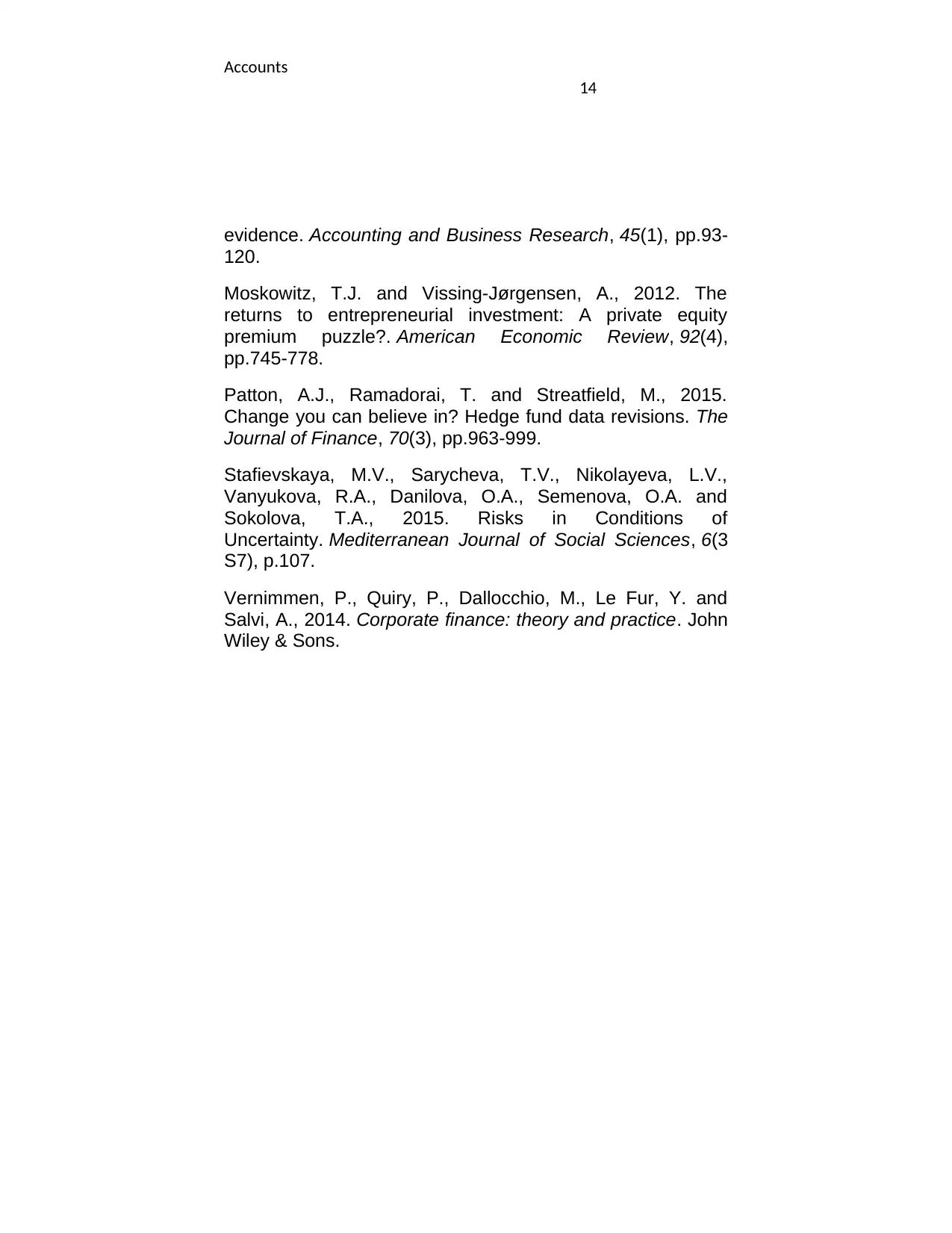
Accounts
14
evidence. Accounting and Business Research, 45(1), pp.93-
120.
Moskowitz, T.J. and Vissing-Jørgensen, A., 2012. The
returns to entrepreneurial investment: A private equity
premium puzzle?. American Economic Review, 92(4),
pp.745-778.
Patton, A.J., Ramadorai, T. and Streatfield, M., 2015.
Change you can believe in? Hedge fund data revisions. The
Journal of Finance, 70(3), pp.963-999.
Stafievskaya, M.V., Sarycheva, Т.V., Nikolayeva, L.V.,
Vanyukovа, R.А., Danilova, O.A., Semenova, O.A. and
Sokolova, T.A., 2015. Risks in Сonditions of
Uncertainty. Mediterranean Journal of Social Sciences, 6(3
S7), p.107.
Vernimmen, P., Quiry, P., Dallocchio, M., Le Fur, Y. and
Salvi, A., 2014. Corporate finance: theory and practice. John
Wiley & Sons.
14
evidence. Accounting and Business Research, 45(1), pp.93-
120.
Moskowitz, T.J. and Vissing-Jørgensen, A., 2012. The
returns to entrepreneurial investment: A private equity
premium puzzle?. American Economic Review, 92(4),
pp.745-778.
Patton, A.J., Ramadorai, T. and Streatfield, M., 2015.
Change you can believe in? Hedge fund data revisions. The
Journal of Finance, 70(3), pp.963-999.
Stafievskaya, M.V., Sarycheva, Т.V., Nikolayeva, L.V.,
Vanyukovа, R.А., Danilova, O.A., Semenova, O.A. and
Sokolova, T.A., 2015. Risks in Сonditions of
Uncertainty. Mediterranean Journal of Social Sciences, 6(3
S7), p.107.
Vernimmen, P., Quiry, P., Dallocchio, M., Le Fur, Y. and
Salvi, A., 2014. Corporate finance: theory and practice. John
Wiley & Sons.
1 out of 15
Related Documents
Your All-in-One AI-Powered Toolkit for Academic Success.
+13062052269
info@desklib.com
Available 24*7 on WhatsApp / Email
![[object Object]](/_next/static/media/star-bottom.7253800d.svg)
Unlock your academic potential
© 2024 | Zucol Services PVT LTD | All rights reserved.





